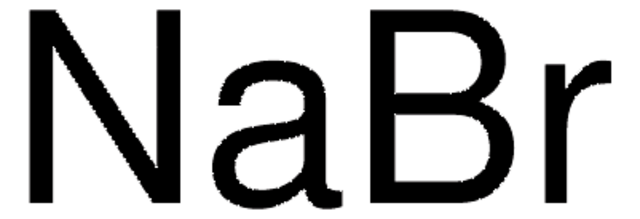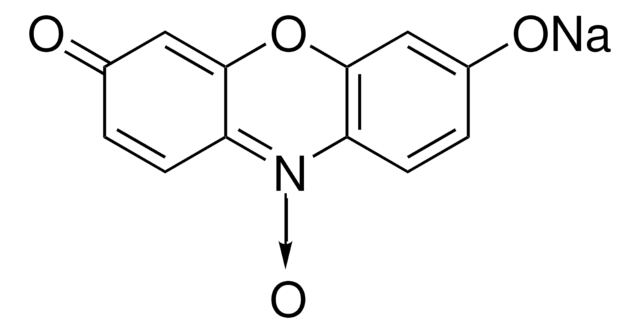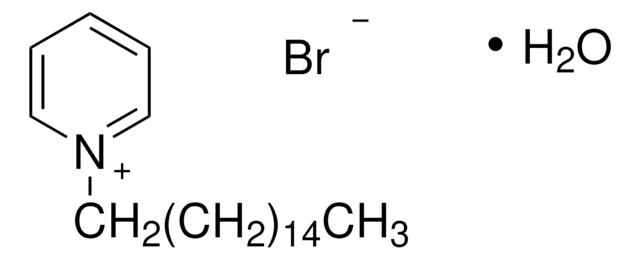Wszystkie zdjęcia(3)
Kluczowe dokumenty
About This Item
Wzór liniowy:
NaBr
Numer CAS:
Masa cząsteczkowa:
102.89
Numer WE:
Numer MDL:
Kod UNSPSC:
12352302
eCl@ss:
38050404
Identyfikator substancji w PubChem:
NACRES:
NA.21
Polecane produkty
klasa czystości
reagent
Poziom jakości
ciśnienie pary
1 mmHg ( 806 °C)
linia produktu
ReagentPlus®
Próba
≥99%
Formularz
powder or crystals
pH
5.4 (20 °C, 50 g/L)
mp
755 °C (lit.)
rozpuszczalność
ethanol: soluble(lit.)
water: soluble(lit.)
ciąg SMILES
[Na+].[Br-]
InChI
1S/BrH.Na/h1H;/q;+1/p-1
Klucz InChI
JHJLBTNAGRQEKS-UHFFFAOYSA-M
Szukasz podobnych produktów? Odwiedź Przewodnik dotyczący porównywania produktów
Opis ogólny
Sodium bromide (NaBr) is an inorganic salt. It is an inexpensive source of bromide anion. It is used as anucleophilic catalyst in organic synthesis. Additionally, NaBr is a useful electrolyte in electrochemical oxidations.
Zastosowanie
Sodium bromide is used:
- As a catalyst for the microwavce assisted three-component cyclocondensation of aryl aldehydes, alkyl nitriles and dimedone for the synthesis of highly functionalized tetrahydrobenzo[b]pyrans.
- As a source of bromine radical in the preparation of bromomethylated γ-lactones via electrochemical oxidative bromination and cyclization series of alkenoic acid derivatives.
Inne uwagi
Informacje prawne
ReagentPlus is a registered trademark of Merck KGaA, Darmstadt, Germany
Redi-Dri is a trademark of Sigma-Aldrich Co. LLC
Ta strona może zawierać tekst przetłumaczony maszynowo.
Hasło ostrzegawcze
Warning
Zwroty wskazujące rodzaj zagrożenia
Zwroty wskazujące środki ostrożności
Klasyfikacja zagrożeń
Repr. 2 - STOT RE 2 - STOT SE 3
Organy docelowe
Central nervous system
Kod klasy składowania
13 - Non Combustible Solids
Klasa zagrożenia wodnego (WGK)
WGK 1
Temperatura zapłonu (°F)
Not applicable
Temperatura zapłonu (°C)
Not applicable
Wybierz jedną z najnowszych wersji:
Masz już ten produkt?
Dokumenty związane z niedawno zakupionymi produktami zostały zamieszczone w Bibliotece dokumentów.
Klienci oglądali również te produkty
Eagleson M.
Concise Encyclopedia Chemistry, 996-996 (1994)
Sergiu Coseri et al.
Carbohydrate polymers, 116, 9-17 (2014-12-03)
Unoxidized and carboxylated pullulan (obtained by pullulan oxidation using TEMPO-sodium hypochlorite-sodium bromide system) have been used as mediators for the silver nanoparticles formation (AgNPs), under environment-friendly conditions: using aqueous solutions, room temperature and notably, by using both mediators as reducing
Ling Yue et al.
Applied biochemistry and biotechnology, 175(7), 3557-3570 (2015-02-05)
A novel aqueous two-phase system (ATPS) only containing Gemini surfactant ethanediyl-1,2-bis(dodecyldimethylammonium bromide) and an inorganic salt sodium bromide was designed, and the physicochemical properties of the ATPS were investigated systematically. The results have shown that the coexisting two phases, one
Sodium bromide catalysed one-pot synthesis of tetrahydrobenzo [b] pyrans via a three-component cyclocondensation under microwave irradiation and solvent free conditions.
Devi I and Bhuyan PJ.
Tetrahedron Letters, 45(47), 8625-8627 (2004)
Julian Holley et al.
Physical review. E, Statistical, nonlinear, and soft matter physics, 84(5 Pt 2), 056110-056110 (2011-12-21)
Excitation waves on a subexcitable Belousov-Zhabotinsky (BZ) substrate can be manipulated by chemical variations in the substrate and by interactions with other waves. Symbolic assignment and interpretation of wave dynamics can be used to perform logical and arithmetic computations. We
Nasz zespół naukowców ma doświadczenie we wszystkich obszarach badań, w tym w naukach przyrodniczych, materiałoznawstwie, syntezie chemicznej, chromatografii, analityce i wielu innych dziedzinach.
Skontaktuj się z zespołem ds. pomocy technicznej










